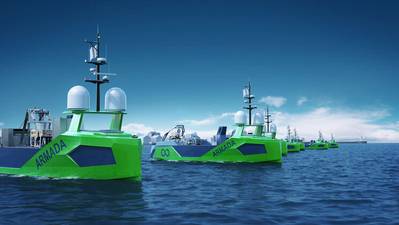Powering the World's First Fleet of Robot Ships
The maritime and scientific community have set themselves the ambitious target to map the entire ocean floor by 2030. Volvo Penta and Danfoss Editron will play a role by powering a novel fleet of unmanned surface robots for subsea exploration.
The companies have been commissioned for the unique venture by Grovfjord Mek. Verksted (GMV) shipyard, to power the world’s first fleet of autonomous robot exploration vessels for commercial use. The seafloor analysis and oceanography company Ocean Infinity has invested in the ‘Armada’ fleet of super-advanced unmanned vessels. The fleet will be made up of two sizes of vessels both of which will be 100% diesel-electric.
Johan Inden, Head of the Marine Segment at Volvo Penta, said, “Together, we will deliver an optimized power solution – to the autonomous Armada fleet – designed for ultimate performance while reducing the environmental footprint. ”
“This is the first time that a commercial autonomous fleet is being developed, rather than just being a prototype,” explains Erno Tenhunen, Marine Director at Danfoss Editron.
The fully hybrid-electric vessels will be powered by Volvo Penta DC gensets and Danfoss DC grid controls. Danfoss will provide the energy management system and propulsion control for each vessel while the engines behind the power management will be variable speed gensets delivered by Volvo Penta.
The Volvo Penta D8 MH variable-speed engine will power the marine generator sets on board. This all-new D8 engine is a perfect match for the autonomous vessels due to its compact size and high power to weight ratio. Additionally, the engine’s low fuel consumption plays a big role in the significant CO2 reduction.
One of the key objectives for a project like this is to deliver a reliable and efficient product. These vessels will be in the open ocean far away from land and maintenance providers. Ocean Infinity needs to know that its vessels are meeting peak performance.
Danfoss Editron, Volvo Penta and Grovfjord are working in close collaboration to enable the Danfoss control system to optimize the use of the Volvo Penta D8 engine for the most efficient power/consumption performance and consequently an optimal environmental footprint. The engine, the generator, and the control system work in perfect harmony.
The generator set is also designed around maximum weight savings and the corporation with The Volvo Penta genset outlet Powerhouse has added an additional element of flexibility to ensure the delivery of the power package suitable for the vessel.
The first four vessels in the Armada fleet are due to be delivered to Ocean Infinity in 2021, with the remaining robots completed in the next months.
The fleet of autonomous vessels will provide new opportunities for deep-sea exploration. Each vessel will be able to launch separate remotely operated underwater vehicles (ROVs). These unmanned submarine-like ROVs will reach depths of up to 6,000 meters and carry out surveys on pipeline routes as well as collect vital seismic data. Currently, ROVs need to be tethered to manned research vessels – with some operation costs in the millions. This new fleet of autonomous surface vessels will mean that ROVs can be operated – without a nearby host vessel – via satellites from onshore facilities in the U.S. state of Texas and the U.K. city of Southampton.
This streamlined approach to commercial deep-sea exploration will help deliver efficient operations, cut costs significantly, and reduce the harmful environmental impact sometimes associated with traditional operations.

















